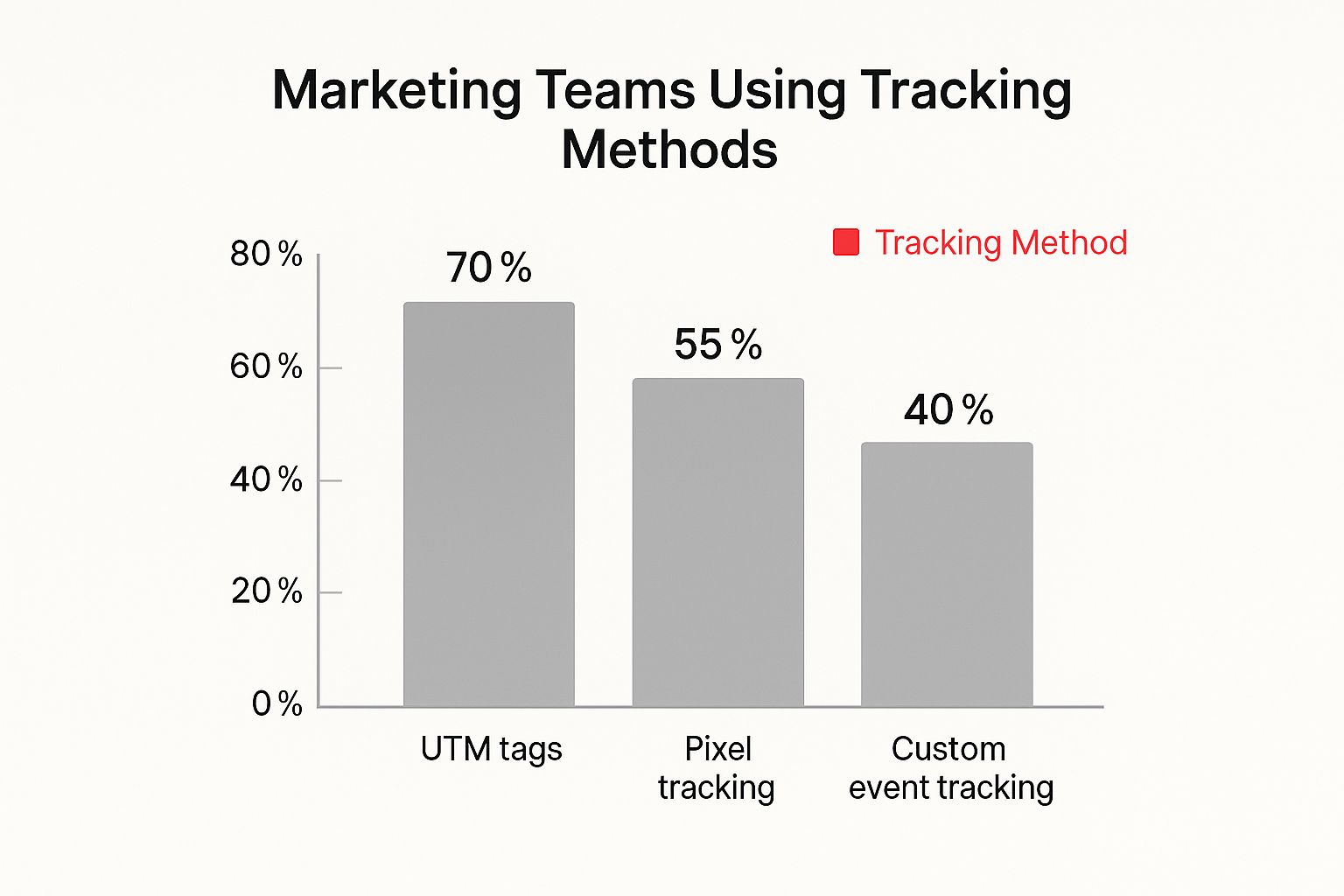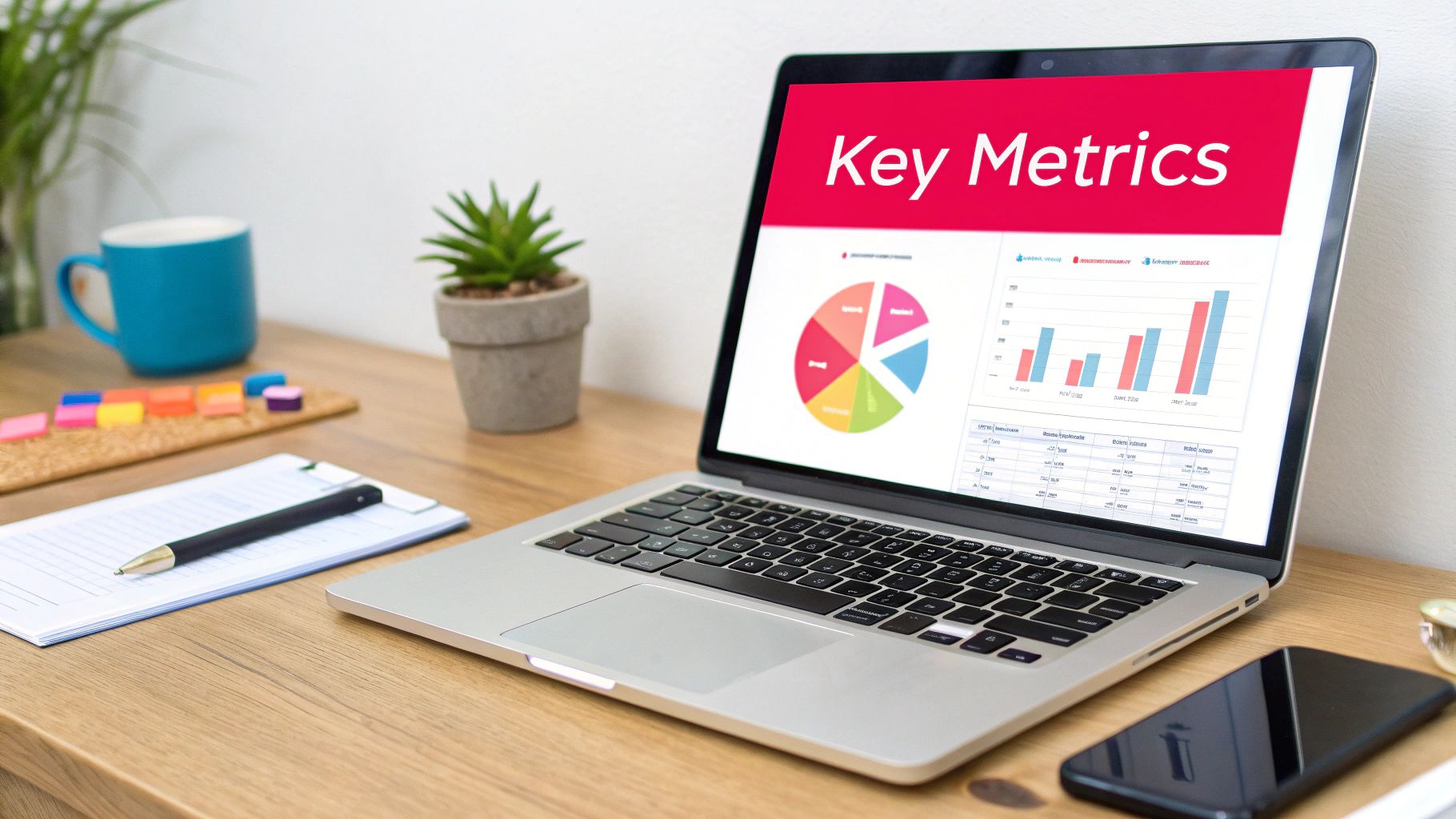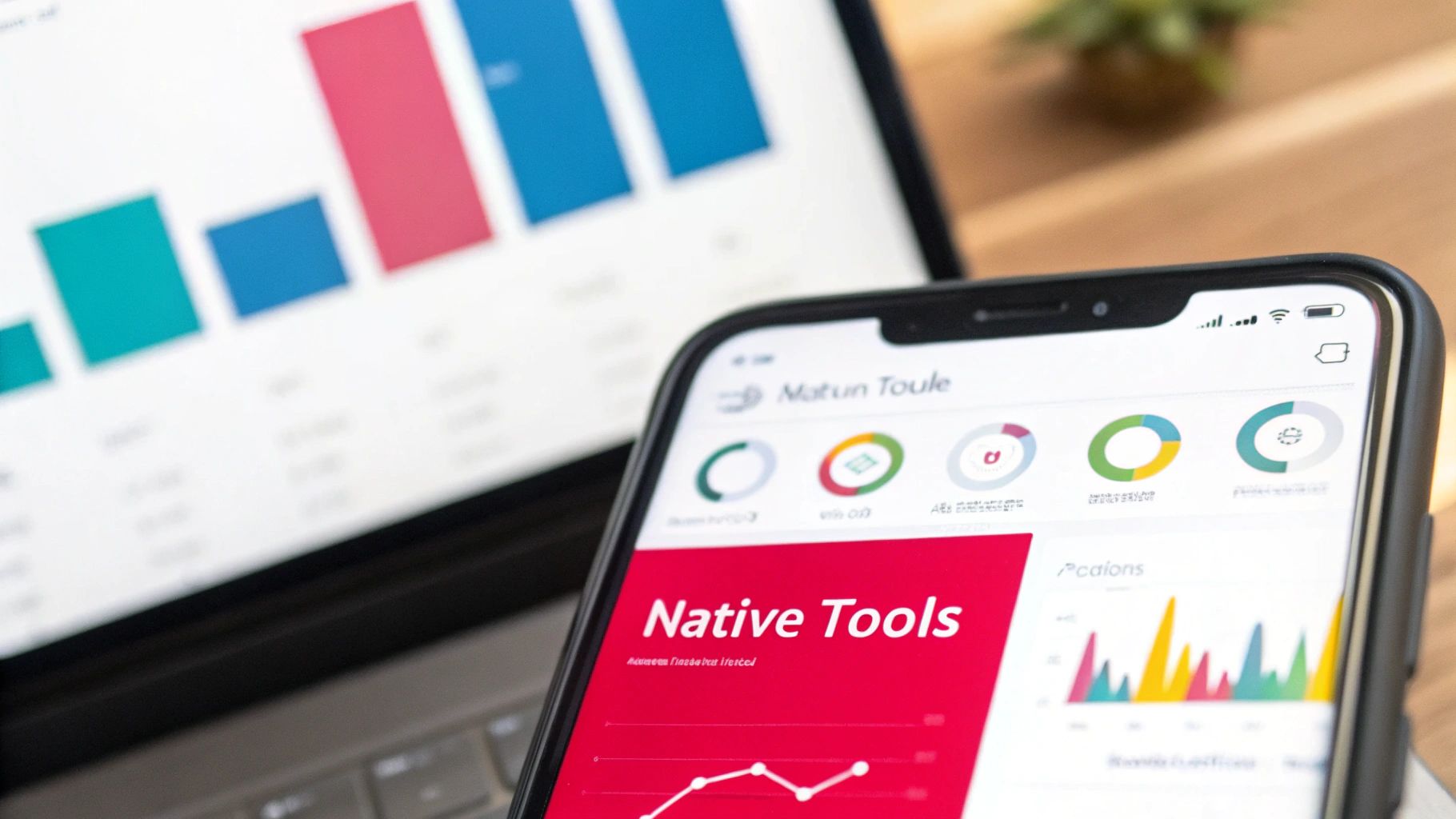 Top 9 Social Media Marketing Best Practices for 2025
Top 9 Social Media Marketing Best Practices for 2025
If you want to get a real handle on your social media analytics, the first thing you have to do is change how you think. It's time to move past intuition and start demanding data. This isn't about gut feelings; it’s about setting clear business goals, picking the right things to measure, and actually looking at the results to make your strategy better. You're swapping out "I think this works" for "I know this works."
Table of Contents
Why Gut Feelings Just Don't Cut It in Social Media
Trying to run a social media strategy on intuition is like trying to drive down a six-lane highway with your eyes closed. Sure, your instincts might nudge you in a decent direction now and then, but they're completely outmatched by the speed and sheer complexity of today's social platforms.
A post might feel successful because a few people left nice comments. But did it actually do anything for your business? Without the data, you’re just guessing.
The amount of activity happening online every second makes guesswork a surefire way to lose. Social media isn't a quaint little town square anymore; it's a bustling global metropolis.
When you make decisions without looking at the analytics, you’re basically ignoring what your entire audience is telling you. The data shows you what they want, when they want it, and how they prefer to see it—that's a competitive edge you simply can't afford to throw away.
The Staggering Scale of Social Media
You really have to appreciate the scale we're dealing with. This isn't just a handful of users. By 2025, it's projected there will be 5.45 billion people on social media worldwide. That's a mind-boggling 67.1% of the entire global population.
These folks spend, on average, 2 hours and 24 minutes scrolling through these platforms every single day, bouncing between about seven different networks each month. If you want to dive deeper into these game-changing numbers, check out the stats on Sonary.com.
These aren't just abstract figures; they represent a massive, data-rich environment. Every like, share, comment, and click is a signal from your audience. Ignoring those signals is like leaving cash on the table.
Justifying Your Marketing Efforts
Beyond just making better content, tracking your social media analytics is how you prove your worth. When you can point to a specific campaign and show it led to a 15% bump in website traffic, or explain how your engagement strategy improved lead quality by 20%, you stop being a "cost center" and become a growth engine for the company.
This data-first approach empowers you to:
- Secure a Bigger Budget: You can confidently ask for more resources because you have the return on investment (ROI) to back it up.
- Spend Smarter: Funnel your ad dollars into the platforms and content that are actually delivering results, not just the ones that "feel" right.
- Show Your Impact: Clearly communicate how your team is contributing to the company's bottom line. This is how you earn trust and get buy-in from leadership.
Making the switch from gut feelings to data-driven decisions is the foundational step. It’s what makes a social media strategy not just effective, but resilient.
Defining Social Media KPIs That Actually Matter
Diving into your analytics dashboard without a clear goal is like trying to navigate a new city without a map—you'll get lost in a sea of numbers. Before you can track anything meaningful, you have to define what success actually looks like for your brand. This means pushing past hollow vanity metrics, like follower counts, and zeroing in on Key Performance Indicators (KPIs) that directly tie back to your business objectives.
The right KPIs are completely dependent on your goals. For an e-commerce brand, success might be all about the conversion rate from Instagram Shopping tags. On the other hand, a B2B company might be laser-focused on the number of qualified leads they get from a LinkedIn whitepaper. Your metrics should tell a story about your business, not just your social media activity.
Aligning Metrics with Business Goals
The first thing you need to do is organize your potential KPIs into buckets. This keeps you from tracking everything under the sun and helps you focus on what truly moves the needle. Most social media metrics fall into three main categories, each one mapping to a different stage of the customer journey.
Awareness Metrics: These numbers tell you how many people are seeing your content. Think of it as the very top of your funnel. The main players here are reach (the number of unique people who see your post) and impressions (the total number of times your post is seen).
Engagement Metrics: This bucket is all about how your audience interacts with what you post. It's a fantastic indicator of content quality and how much your audience is connecting with your message. You’ll want to look at comments, shares, likes, and especially saves.
Conversion Metrics: This is where the magic happens—where your social media efforts connect directly to business results. These metrics track the specific actions you want users to take, like website clicks, form submissions, add-to-carts, and, of course, sales.
The goal isn’t to have the highest numbers across the board. It's about excelling in the categories that truly matter for your specific business objective. A post with sky-high reach but zero clicks isn’t a win if your goal is to drive website traffic.
Speaking of conversions, you need reliable ways to track actions that happen off the social media platform. This is where a lot of brands struggle, but the pros have their methods down.

The data is crystal clear: a whopping 70% of marketing teams rely on UTM tags. This makes them the undisputed champion for tracking traffic sources and proving that your social media efforts are actually paying off.
To make this crystal clear, let's connect some common business goals to the KPIs that best reflect them. It’s all about tracking what will actually inform your strategy.
| Matching KPIs to Business Goals | ||
|---|---|---|
| Business Goal | Primary KPIs | Example Scenario |
| Increase Brand Awareness | Reach, Impressions, Share of Voice | A new startup wants to get its name out. They track how many unique users see their posts and how often their brand is mentioned compared to competitors. |
| Generate Website Traffic | Click-Through Rate (CTR), Cost Per Click (CPC), Social Referral Traffic | A SaaS company wants to drive potential customers to a new feature landing page. They focus on how many people click their links and the cost associated with each click. |
| Boost Audience Engagement | Comments, Shares, Saves, Applause Rate (Likes per follower) | A lifestyle brand wants to build a loyal community. They track conversational metrics to see if their content is sparking discussions and resonating with their audience. |
| Generate Leads & Sales | Conversion Rate, Cost Per Lead (CPL), Return on Ad Spend (ROAS) | A direct-to-consumer (DTC) store is running a promotion. They measure how many visitors from social media make a purchase and the revenue generated for every dollar spent on ads. |
As you can see, the goal dictates the metric. Once you're clear on your objective, choosing the right KPIs becomes second nature.
Building Your Custom KPI Dashboard
Now that you understand these categories, you can build a custom dashboard—whether it’s in a simple spreadsheet or a dedicated analytics tool—that mirrors your priorities. Don't just grab a generic template off the internet. Always start with your main business goal and work backward to select the KPIs that matter most.
Let's walk through a real-world scenario. Imagine a DTC brand that sells skincare, maybe one that uses a platform like JoinBrands to source creator-generated content for a new product launch.
Their primary KPIs wouldn't be something fluffy like post likes. Instead, they would be intensely focused on:
- Click-Through Rate (CTR) on creator posts that link to the product page.
- Conversion Rate from all social referral traffic.
- Return on Ad Spend (ROAS) for any paid campaigns that use that creator content.
This focused approach makes sure that every single piece of data you track gives you a clear answer to the most important question of all: "Is our social media strategy actually helping us grow the business?"
Choosing Your Social Media Analytics Toolkit
Once you have your KPIs locked in, the next logical move is picking the right tools to track them. Your approach here really depends on your budget, how big your team is, and just how ambitious your goals are. You’ve basically got two main paths: stick with the free, built-in tools from the social platforms themselves, or invest in a dedicated third-party platform.
From my experience, the smartest strategy isn't an either/or decision. Most brands find a sweet spot by creating a hybrid approach. This gives you the best of both worlds—deep, specific insights from each platform, plus a high-level, consolidated view of your overall performance.
Starting with Native Analytics Tools
Every major social media platform gives you its own free analytics dashboard. If you're just starting out or working with a shoestring budget, these native tools are a fantastic entry point. They serve up essential data straight from the source, so you know you can trust its accuracy.
Here’s a quick rundown of what to expect from the big players:
- Meta Business Suite (Facebook & Instagram): This is your command center for tracking performance across both platforms. You’ll get a solid overview of reach, impressions, engagement, and basic audience demographics.
- LinkedIn Analytics: A must-have for B2B marketers. This tool gives you a peek into your follower demographics by job title, industry, and company size, on top of the standard post-performance data.
- TikTok Analytics: You might be surprised at how deep this one goes. It offers a detailed look at video views, follower growth, profile views, and even tells you when your audience is most active.
The biggest downside? Native tools live in their own little bubbles. To see the whole picture, you have to manually pull data from each platform and stitch it together in a spreadsheet. That gets old, fast.
The Power of Third-Party Analytics Platforms
This is exactly where dedicated third-party tools come to the rescue. Platforms like Sprout Social, Hootsuite, or Buffer were built to solve the silo problem. They plug into all your social profiles and pull every bit of data into a single, unified dashboard. It’s a massive time-saver, but it also unlocks much more sophisticated analytical power.
The real magic of a third-party tool is its ability to give you a cross-platform perspective. You can instantly compare your engagement rate on Instagram versus LinkedIn or see your total reach across all channels with one click. That consolidated view is absolutely critical for making smart, holistic strategic decisions.
Think about how people actually use social media today. It's not just one network. By 2025, the average person will be active on 6.83 different social networks every month. This multi-platform habit, combined with a social ad spend projected to hit a staggering $276.7 billion in 2025, makes a unified analytics view non-negotiable. You can explore more of these social media statistics on SproutSocial.com to see just how critical this is.

This data shows a clear trend: advertising spend is shifting, with mobile set to completely dominate by 2030. It’s just another reason why you need tools that can track performance seamlessly across every device and platform your audience uses.
Another huge win for third-party tools is their advanced reporting. You can generate custom, presentation-ready reports that blend data from all your networks, run competitive analysis to benchmark against others in your space, and even use social listening to keep an eye on brand mentions and industry chatter.
For a growing brand or agency, these aren't just nice-to-haves; they are strategic necessities for managing your social presence efficiently and effectively.
Turning Data Overload into Actionable Strategy

Let's be honest, collecting social media data is the easy part. The real work—and where the pros pull ahead—is in turning that mountain of numbers into a clear, actionable game plan. It’s all about moving past basic reporting and starting to ask the right questions.
So a post got 5,000 likes. Great. But why? Was it the video format, the time you posted, the question you asked in the caption? This is the kind of thinking that transforms raw data from a boring spreadsheet into your brand's most powerful strategic asset.
To make this happen, you need a regular review process. I don't care if it's weekly or monthly, but setting aside dedicated time to actually look at your social media analytics is completely non-negotiable for growth.
Asking the Right Questions
Your data is packed with stories, just waiting for you to find them. To uncover these narratives, you have to get in the habit of digging into the "why" behind your metrics. Don't just take the numbers at face value; challenge them.
Start by asking questions that link performance back to your goals:
- Engagement vs. Clicks: Why did that one post get a ton of comments but almost zero website clicks? Was the call-to-action missing, or was the content just so good that people wanted to talk about it right there on the platform?
- Format Performance: Which video style—a quick Reel, a detailed YouTube tutorial, or a behind-the-scenes Short—really clicks with our audience on Thursdays?
- Audience Behavior: We're seeing an engagement spike every Friday at 7 PM. What are people doing then, and how can we create content that fits perfectly into that moment?
Questions like these shift you from being a data collector to a data interpreter. This is where you find the gold—the insights that lead to smarter decisions, like reallocating your video budget or tweaking your posting schedule for maximum impact.
The most important question you can ask about any metric is simply, "So what?" A high reach number is just a vanity stat until you figure out what it means for your business goals and what you should do about it.
Conducting a Monthly Analytics Review
A structured monthly review is your chance to spot trends, understand why some things flopped while others flew, and connect your social efforts to real business outcomes. This isn't about creating a report that gets filed away and forgotten; it's a strategy session with your data.
Once you have your numbers, the next step is to translate them into action. A fantastic way to get a framework for this is by learning about conducting a comprehensive social media audit. It provides a structured process for a really thorough evaluation.
During your review, zero in on these three areas:
- Performance Against KPIs: How did you stack up against the goals you set? If you fell short, dig into the data to understand why. If you blew past a goal, pinpoint what worked so you can do more of it.
- Content Analysis: Pull your best and worst-performing posts from the month. Look for the common threads. Was it the topic? The visual style? The caption length? What made the difference?
- Strategic Adjustments: Based on everything you've learned, what will you start, stop, and continue doing next month? This simple framework turns your review into a concrete action plan and ensures your strategy is always evolving based on real feedback.
Using AI and Social Listening for Deeper Insights

Once you've got a handle on tracking your own KPIs, the real game-changer is understanding the chatter that happens outside of your posts. This is the world of social listening. It’s a proactive strategy that goes way beyond just measuring your own performance. You’re essentially tuning into what people are saying about your brand, your competitors, and your industry across the entire social web—even when they don't bother to @ you.
Think of it as having a digital ear to the ground. Let’s go back to that skincare brand we talked about. Say they're using a platform like JoinBrands to manage their creator content. With social listening, they could spot a rising trend in "glass skin" routines. This insight lets them immediately assign new content briefs to their creators, jumping on the trend before competitors who are just staring at their own engagement numbers even know what's happening.
Let AI Do the Heavy Lifting
Look, nobody has the time to manually sift through millions of online conversations. It’s impossible. This is where Artificial Intelligence (AI) becomes your best friend in tracking social media analytics. AI-powered tools can chew through massive amounts of text and data in seconds, pulling out insights a human team might miss entirely or take weeks to find.
This isn't some futuristic fantasy; these are practical tools delivering real-world results right now. The blend of AI and social listening has completely changed the analytics game, making brands more efficient and better connected to their audience. People spend over 14 billion hours on social media every day. The businesses that know how to tap into that data are the ones winning.
In fact, the numbers don't lie. 90% of businesses using generative AI report huge time savings, and 73% see actual increases in engagement. Marketers using specialized social listening tools are twice as confident in their social media ROI. You can see more of these powerful stats over on Talkwalker.com.
So, what can AI do for you?
- Analyze Audience Sentiment: It automatically figures out if mentions are positive, negative, or neutral. This gives you a quick, at-a-glance read on your brand's health.
- Identify Emerging Trends: AI can spot recurring keywords and topics before they hit the mainstream, giving you a serious first-mover advantage.
- Predict Post Performance: Some of the more advanced tools can even analyze content you're about to post and predict how well it will perform based on past data.
From Reactive to Proactive
The real magic of this approach is that it flips your strategy from being reactive to proactive. Instead of just reporting on what happened last month, you can start anticipating what's just around the corner.
Social listening is your early warning system. By monitoring sentiment, you can catch negative feedback and address a customer service issue before it snowballs into a public relations crisis. This proactive stance protects your brand's reputation and builds trust.
For example, imagine a direct-to-consumer brand notices a small but steady trickle of untagged posts complaining about a product's packaging. With AI-powered social listening, they can spot this pattern early on. They can then jump on it, address the issue publicly, offer a fix to the affected customers, and pass that feedback straight to their product team. This all happens before the problem gets out of hand.
That's how you use analytics not just to look back at the past, but to actively build a better future for your brand.
Answering Your Social Media Analytics Questions
Once you start digging into your social media analytics, the practical questions start popping up fast. There isn’t a single "right" answer for every single brand, but if you have a solid framework in your back pocket, you can make smarter decisions that actually fit your team and your budget.
Let's break down some of the most common hurdles marketers face when they begin to let data guide their strategy.
How Often Should I Check My Analytics?
The honest answer? It completely depends on your team’s rhythm and how fast your campaigns are moving. You definitely don’t need to be glued to a dashboard 24/7, but you can’t let the data gather dust, either. A balanced approach is almost always the way to go.
Here's a cadence that works for most teams:
- Daily Peeks: A quick, five-minute glance at your core metrics is perfect. Look for things like comments, mentions, and any sudden engagement spikes. This is your early warning system for spotting a potential crisis or a post that's starting to take off.
- Weekly Reviews: Set aside a dedicated block of time—maybe first thing Monday morning—to look back at the previous week. This is your chance to make small, tactical tweaks to your content calendar for the week ahead based on what worked and what didn't.
- Monthly Deep Dives: This is where you zoom out for the big picture. You'll analyze broader trends, see how you stack up against last month, and honestly assess if you’re on track to hit those bigger KPIs you set.
"Daily, we track the basic metrics—engagement, reach, and clicks—so we can spot any sudden spikes or drops. But we reserve Fridays for more in-depth analysis to assess weekly trends."
— Tom Edwards, Founder of Bit Quirky Consulting
What Are the Most Important Metrics to Track?
This is the million-dollar question, and the answer is always the same: it depends entirely on your goals. Seriously. Tracking vanity metrics that don't connect to your objectives is just as useless as tracking nothing at all. You have to tie what you measure to a real business outcome.
For instance, a DTC brand laser-focused on sales should be obsessing over:
- Conversion Rate from their social ads.
- Return on Ad Spend (ROAS) for every single campaign.
- Click-Through Rate (CTR) on any posts that feature tagged products.
On the other hand, a B2B company trying to build brand authority would care more about:
- Share of Voice within their specific industry.
- Engagement Rate on their LinkedIn thought leadership content.
- Follower Growth from people with specific, relevant job titles.
How Do I Prove Social Media ROI?
Proving your Return on Investment (ROI) is the key to keeping your budget and showing just how valuable your work is. The secret is to draw a straight line from your social media efforts to tangible business results.
First, you need to calculate your total investment. This includes not just ad spend, but also the cost of your social media tools and even the value of your team's time.
Next, you have to assign a clear monetary value to your conversions. For an e-commerce brand, this is easy—it’s the total sales that came directly from social media. For lead generation, you can calculate the value of a lead by looking at your historical lead-to-customer conversion rate and the average lifetime value (LTV) of a customer.
When you track this data, you stop guessing. You can walk into any meeting and show exactly how your social strategy is contributing directly to the bottom line.
Ready to connect with creators and generate authentic content that drives these metrics? JoinBrands provides the all-in-one platform to find influencers, manage campaigns, and accelerate your sales with powerful user-generated content. Start your campaign today!








